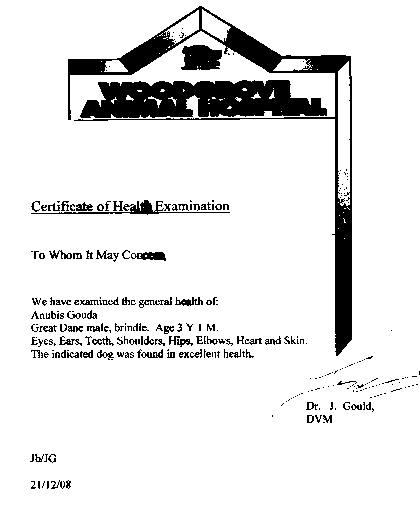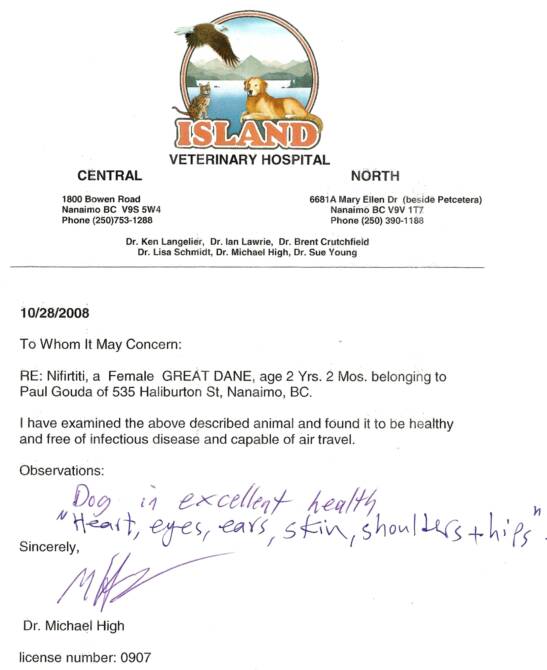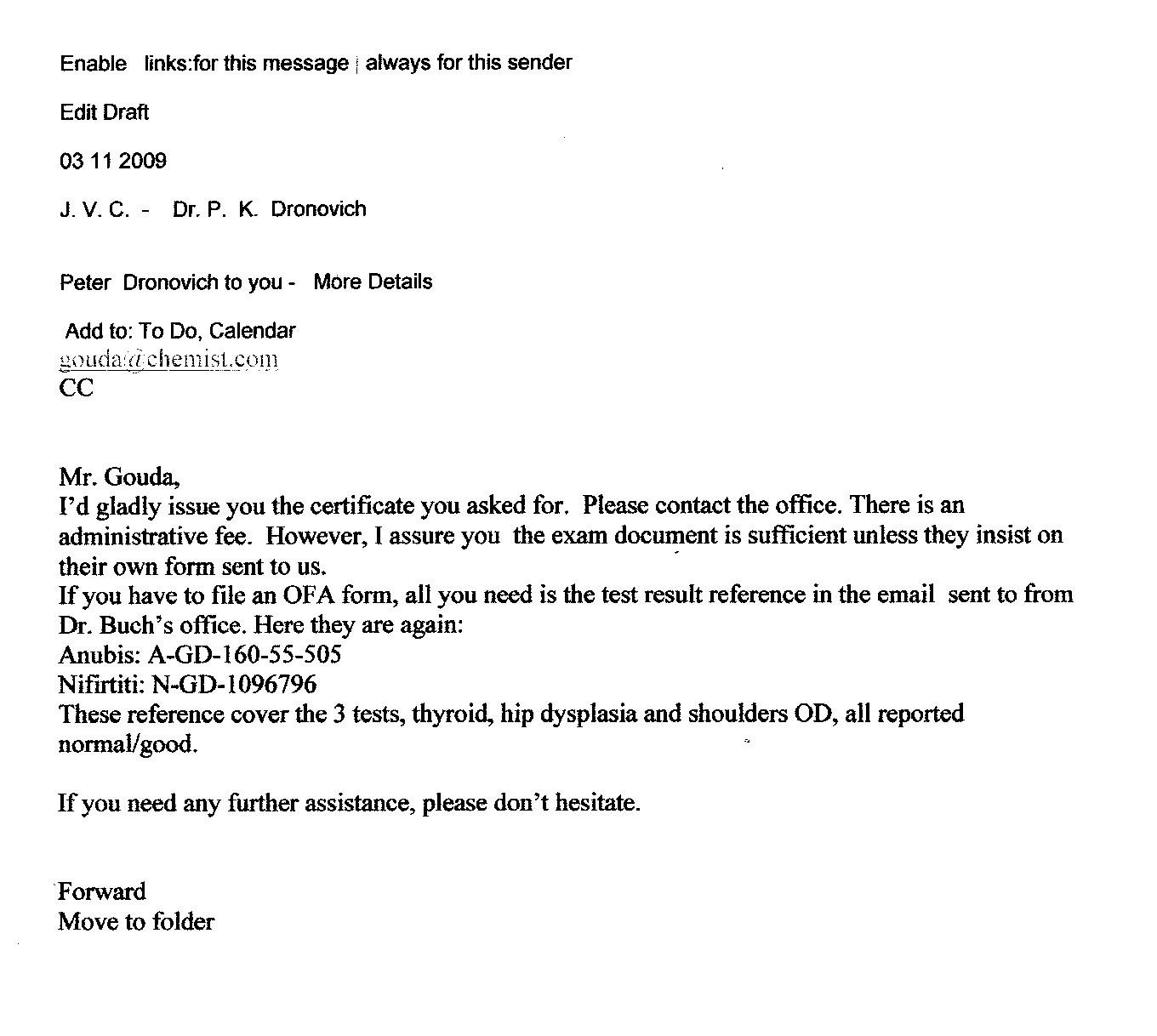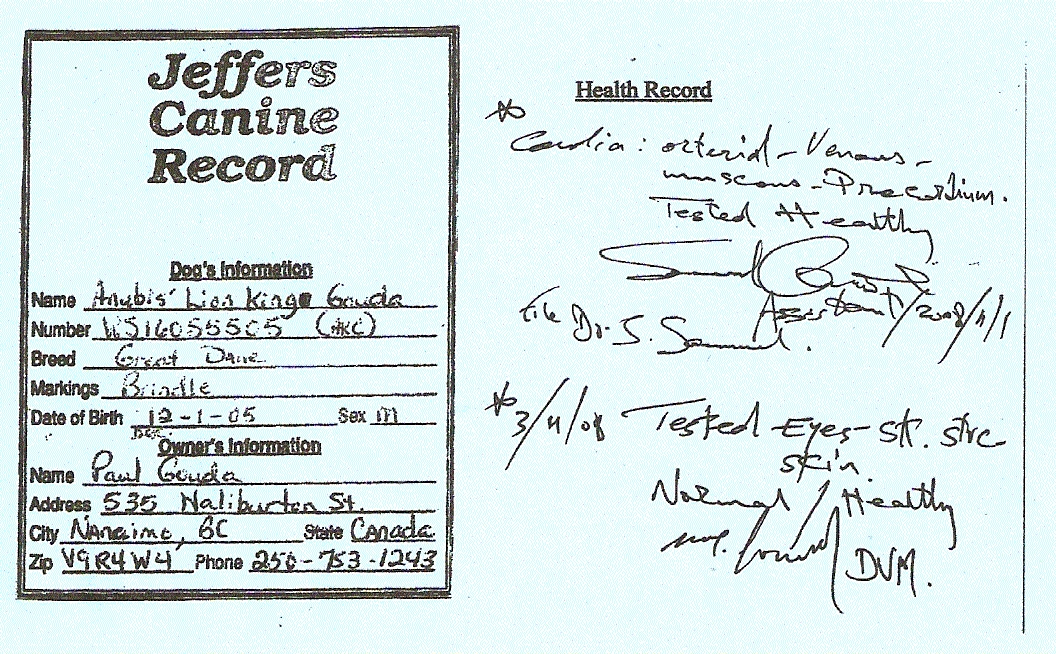2- When you buy a pup, you want to make sure it's a healthy line. How do you do that?
Of course I did all the tests, hips, thyroid, heart, eyes ... So is there a difference bewteen how one test was done and another? Yes, more like "when" it was
done.
I received several emails from families who had severe health problems with Danes that come from adults who at one point (at a young age) were testsed and cleared. Commercial breeders would tell you their dogs are safe because they either don't have a problem, or because they did the heart and hips tests and submitted the results to a commercial data filing web site such as that called OFA. That's almost good, but, it means nothing really. They don't tell you that these tests were done when the Dane is still really a pup and any pup should pass such tests. Let me explain.
First I have to admit I never heard of OFA until three different families with adult Danes with severe health problems called me and told me about their Danes' health problems and that they are surprised because the 3 breeders had their breeding Danes registered with OFA. So I looked into the OFA approach and though, as I'll explain, it was obvious it's a commercial gimmick signifying nothing, I still felt at least there is no harm registering my Danes tests with them just in case I have a very good home for a pup who will be under the wrong impression that the Dane's health is second best. Well ...
.
Commercial breeders who plan on selling lots of pups would get that test done for their Danes just so they could say my Dane is healthy. The plain fact is, this test is done too early, between age 1 to 2 years while the Dane is basically still a pup. Even worse as in one case, a BC breeder had this test done a second time because she failed the first one! And, as I said, any pup should pass such tests unless the yet-to-be-developed problem will be, years later, really severe. The mistake some assume is that these issues are basic genetics and as simple as a DNA structure detected at any age. This is not true.
While as I said there is no harm filing such test with a data base site, there are three problems with interpreting the site as a proof of good health:
i) At age 1 to 2 years old, reported BDL of the test (Below Detection Level) is 5 times the same DL at age 4 years, and as such, no definite detection can be claimed
with any degree of certainty at age 1-2. Not seeing it would not mean it is not there. The baseline noise Vs the modest peak has a very high ratio. Yet, in North America, as a commercial operation that wants more customers and wants to please and entice breeders to pay for filing that test with them, they make it easy for the customer to pass so they would get a (paid for) site reference number satating that the dog is registered with them based on a vet certificate that the dog is healthy (again, healthy at age 1 for some tests & 2 years for one test). The breeder now has purchased the meaningless phoney bragging rights. Only in North America!
In Europe, ABK (and also EBS with which our Cleopatra and her parents are registered) they do not accept such tests until the dog is 4+ years of age.
OFA site record would have been a good reference if it didn't allow breeders to submit tests while the Dane is still a pup. When you check out a Dane's record online, you don't know when these tests were done, and the earlier they are done, the easier the dog wiill pass (and the more customers the site will get) - and that's what makes such system meaningless.
Now here is the proof: 3 cases, people who purchased Danes from Alberta, BC and the States, from 3 breeders who told the applicants that the sire and dam are tested and have an OFA clearance number, the 3 families ended up with Danes that developed hips, thyroid and heart problems as early as age 3 to 4 years old.
Theses families were looking for a second Dane and they contacted me, and I have recently brought back this issue to their attention and asked them if I could use their cases as a proof, to make this point, I asked permission to publish their contact info for a reference, and they agreed. Below you'll find the contact info if you wish to hear from them directly. All 3 families had a pup from parents that their only basis for being healthy was tests done at 1 to 2 years old submitted to that commercial data base. All 3 families had problem Danes.
The thyroid, hips and heart exams (X-ray test in particular) mean nothing at age 1-2 years old and will show only a specific type of problems or a problem that will be considerably severe at age 4+
Being X-rayed clear or saying that the heart beat sounds good at age 1-2 is not a sufficient answer in any way, not even close. I am sure OFA will not easily change its SOP (Standard Operating Procedure) to require these tests at age 3-4 as practiced overseas, because OFA would then lose many "customers". And, before I forget, here is the info of those 3 families who had disaster Danes from commercial breeders with technically health cleared Danes (again, cleared at age 1-2 years):
Ketty Breeze: kettybreez@usa.com
Tim Bucha: tbucha@dr.com cell 604-727-4431
Sarah Green: sarahgreen19780@gmail.com All 3 can also be reached via the social network FaceBook under the email addresses shown.
Obviously, being OFA registered is not a measure of peace of mind assurance of health. It is not even a "something better than nothing" case, as it means nothing at that young age.
When I first bred, I only wanted to make friends and family kids happy with a Dane pup. I still did all these tests as a first step only, and I repeated them. Some were done locally at the local vet clinic, a couple while on vacation in North & South America including the States. But then, when I finished them merely for my peace of mind, and didn't send the fees to the commercial OFA site to file them (to be honest, fees would have added up to about $500 total for both dogs) - as I felt it meant nothing, sure enough one of the bitter breeders starting saying, why are his Danes not OFA listed? My first reaction was kind of "I don't care and I won't play this game. I breed when I want to people I know and I know I have done all tests and copies were given as part of the pup's file" - then I thought, well, I may have a pup or even two that needed good homes, good homes that may not understand. So, recently, I put these certificates together in a file and I found myself pressured to file them just to have the meaningless bragging rights others have!!! Commercial sites such as OFA or JCR "Jeffers Canine Records" provide at most a minimal early diagnostic data, not a real definite diagnosis and surely not a therapeutic, corrective preventative approach.
So, what is the answer and how to really know if the line is healthy:
a) Vet certificates of clearance at age 4+ years. (again, 2 of OFA tests are done at age 12 months, another 1 or perhaps 2 maximum are at just 24 months of age and
that's it way too young).
b) The established facts of the line history, the parents and grandparents of the sire & dam, how old, how healthy.
c) Most importantly, the breeder. Cases such as a blue collar backyard guy or a house wife breeding to make a few hundred dollars are very well an alarming indication
of potential problems. In some countries, a breeder has to be very well a vet (well, he has to take a very extensive veterinarian course. One couldn't just breed and
sell pups as allowed in North America). The other 3 Dane breeders I communicate with are vets & chemists. Ask about the breeder.
This brings us to the next health issue:
ii) Commercial breeders who are blue collar workers or house wives do not have the knowledge to deal with a very important health issue. They can get away with
breeding cats and toy or basic dogs, but when it comes to the special giant breed, there is a lot more to it than mating the male with a female. Yes, chances are, those breeders can only get the dogs to mate and very much leave things to nature. Well, in nature large breeds suffer many problems that need to be prevented by us who developed these breeds.
In nature, at age 2, 3 or 4 years and up , large breeds develop problems related to bone composition which is influenced by pregnancy nutrition and the diet during the first 6-8 weeks. It is not a fate or a must-happen thing. No, it can be prevented and corrected. We are a living prof with absolutely 100% success record. And no, not bragging and not promoting. Please read & listen.
If you leave it to nature, most likely you'll get the problems they get in nature.
But, if you don't know what you are doing, and give the wrong ratio of supplements, you'll also cause developmental problems.
That's why some argue that Danes, mastiffs and hounds should only be bred by a vet, a chemist or under a close supervision of a vet, and not just any vet either.
As I explained previously, the problems that happen in nature and happen to Danes from commercial breeders, can be totally eliminated with the right supplementary diet.
I emphasize the fact that the problems of large breeds can be 100% prevented by correcting their physical development with proper care starting with THE MOTHER prior to and during pregnancy. I prepare 4 different mixes myself, but - and please, this is not a childish ego thing - I am a chemist with a doctor degree - which, yes, I know not the average breeder nor am I trying to imply that the breeder has to have a Ph.D. in chemistry ... come on ... but, surely a reasonable training or background or understanding is a must. A blue collar or a house wife breeding giant breeds is the other extreme.
A careful experienced diet including glucosamine, chondroitin, methyl sufonyl methane (or msm), several specific B vitamins such as riboflavine, chlorthydate, cyanoncobalamine as well as several other vitamins and minerals in a very specific ratio - given a month to 2 months prior to pregnancy and a different combination-ratio throughout pregnancy totally eliminates such potential danger.
One breeder said that dog food already has glucosamine and chondroitin. Well, she didn't know that the Dane pup would then need to eat 2.5 kg a day of that food to get the booster he needs for a healthy development during the first 10 weeks of his life - and, by consuming that much (even if possible, and it isn't) the pup would develop problems due to the excess of other elements in the dog food. The following 3 months to age 6 months, he can be OK with good giant breed puppy formula supported by raw meat and goat milk, then past 6 or 7 months the critical development period is almost over. Yes, without the care and expense during the first 3 months of the puppy's life (and during pregnancy) the Dane will later have the problems he would have in the wilderness (or in puppy mills).
Her problem of course, to be frank, is that, for example, "cosequin" tablets for joint health development in Dane pups is $55 for one 60 tablets bottle, meaning almost $1 a tablet. Supplementary feeding of the mother before pregnancy, 2 months during pregnancy and the the pups for 2 to 3 months can mean minimum $5 a day plus another $3 goat milk, raw meat and special food daily - which would cost about $170 + $380 a pup ( $170 a pup pre-birth based on an average 7 pups litter - and the cost of the pup's 2-3 months of the same diet is another minimum $380) - meaning that this area alone would have cost her about $550 a pup. And commercial breeders may try the BS talk, but it's sales talk. They won't spend the money on supplementary diet and they don't even see why they should. Funny though, one breeder was given a writeup by a European research centre supporting what this site declares. She then started to state on her site that she "does supplementary feeding"!!! First I hope she didn't because she surely would cause more harm not knowing what she is doing; and it's the poor permanent home is the one who will suffer as the Dane suffers later. Second, she breeds for profit and no way she'd spend that kind of money on the pups.
iii) Problems such as shoulder and hip cases are not a mere hereditary issues. They are hereditary potential. They mainly develop as a chemical imbalance in the cells and specially in the basic bone structure. As explained above, even if there is no hereditary problem detected in th pup at age 1-2 years, it will develop without the right supplementary care. And, even if there was a hereditary element, again it is only a potential, not a must, and it can be prevented, corrected and eliminated with the right supplementary diet.
So, how healthy the pup will be, is how educated and non-profit oriented is the breeder and how caring is the home. And this, please, is by no means blowing our own horn, so, take our now rather than learning the hard way.
The real assurance of a good potential future health is:
1- Vet certificates of health clearance at the adult stage, around the 3-4 years old and up.
2- An educated breeder and a good breeding programme.
3- The educated and costly supplementary diet prior to, during and post pregnancy. Clear tests without this factor still have the potential of later-problems as I
explained. Hips, shoulders and other concerns are not a mere hereditary issue, it is also a developmental issue.
4- A confident health guarantee in writing. Not the 6 months or the one or even two years limited warranty. When a breeder claims healthy Danes yet he wants to
guarantee the health to 2 years only (when actually any potential problem starts to appear), there is something wrong here.
Finally, I hope you understand that this is a mere educational material, not sales talk. We breed for fun, for friends & family mainly and we have very few pups available to the public (and we are the envy of some commercial backyard breeders). In fact, it seems that another couple more breedings might be the end of our breeding activities at least for a while - subject to the exceptional occasional sufficient number of goof friends applicants every now and then.
Good luck and don't hesitate to ask for advice.









